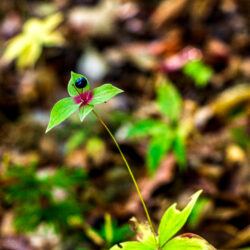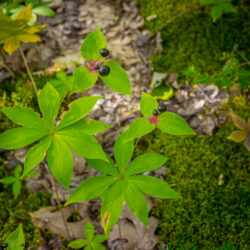Etymology
Medeola is Greek, honoring the sorceress Medea; Virginiana is Latin for Virginia.
Native Habitat
Mesic open woodlands.
Garden Uses
Perfect for shady woodland or rain gardens, this interesting plant spreads slowly to naturalize with 3 season interest.
Overview
An open woodland native of the eastern US, this 1-2 foot tall perennial herb prefers moist part-shade to shade. Each graceful nodding stem bears an interesting, small yellow-green flower above whorled leaves, but it was traditionally valued for its thick (1 inch diameter), brittle, juicy root, similar in texture and fragrance to a cucumber. Because of its current scarcity, digging it as a food crop is not recommended.
Leaves and Stems
Leaves form as two separate whorls, a larger whorl of 5-9, 5-inch lanceolate to ovate leaves at mid-stem, with a smaller whorl (3, three-inch leaves) above. In autumn, leaves turn reddish purple, contrasting nicely with the bluish fruit. Each single stem is hairy and unbranched as it rises from its rhizome. Non-flowering plants have one whorl and can be confused with star flower (Lysimachia borealis).
Flowers
The greenish-yellow, 6-part flowers (1/2 inch diameter) appear in late spring, drooping from the terminal axil of the top whorl. The petal-like tepals turn backward.
Fruit/Seed
The small berry ripens to bluish-purple.
Wildlife Associates
Birds are attracted to the fruit.
Propagation
Divide in spring as the plant comes into growth or sow the seeds as soon as they are ripe in the autumn.
Ethnobotanical Uses
The root tastes and smells somewhat like a cucumber.
Anecdotal Information
This plant may be best appreciated in the wild or propagated by seed.
Sources
Lady Bird Johnson Wildflower Center
Wisconsin Herbarium Consortium, Flora of Wisconsin
Plant Profile by Kate O’Dell




